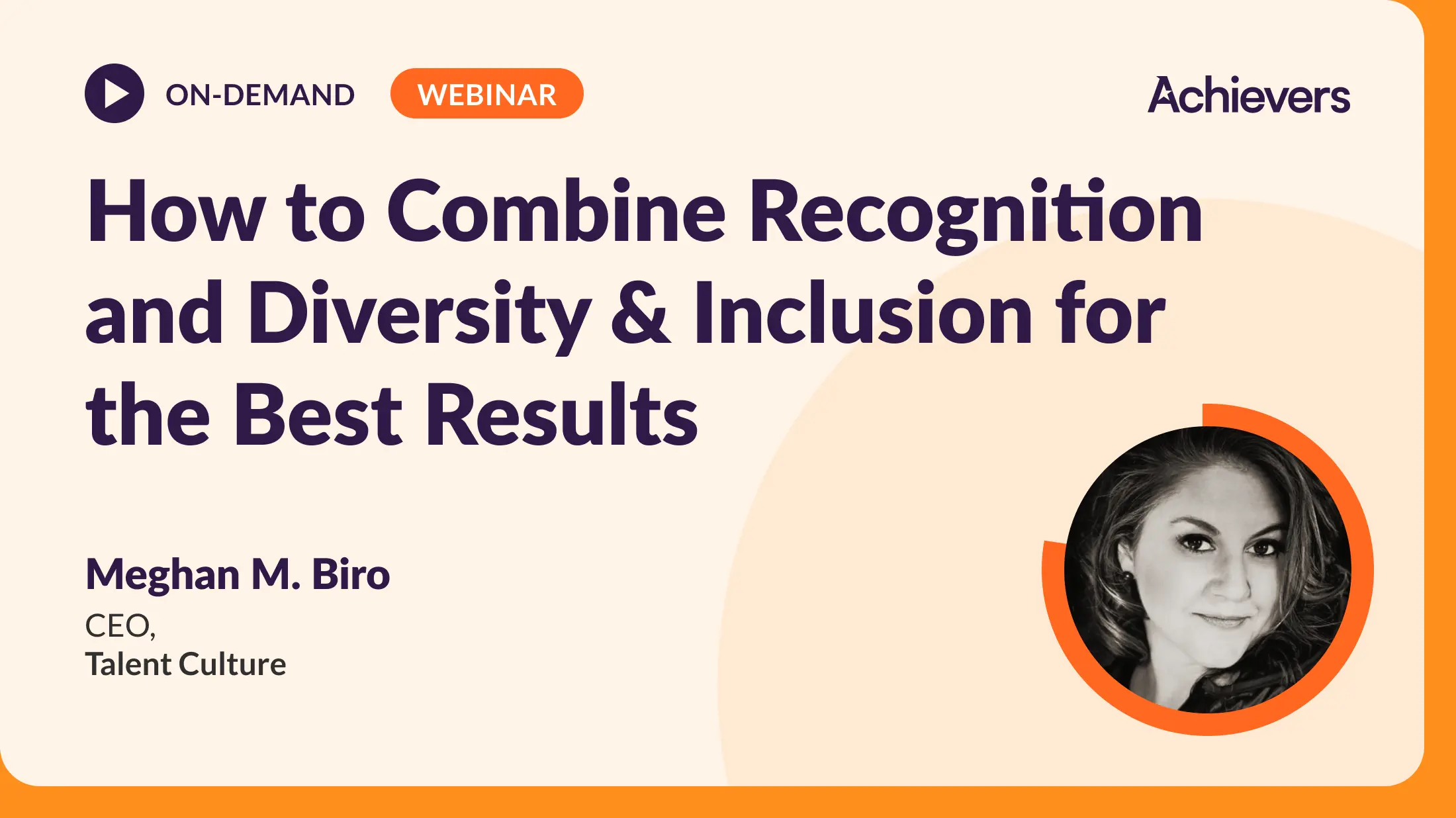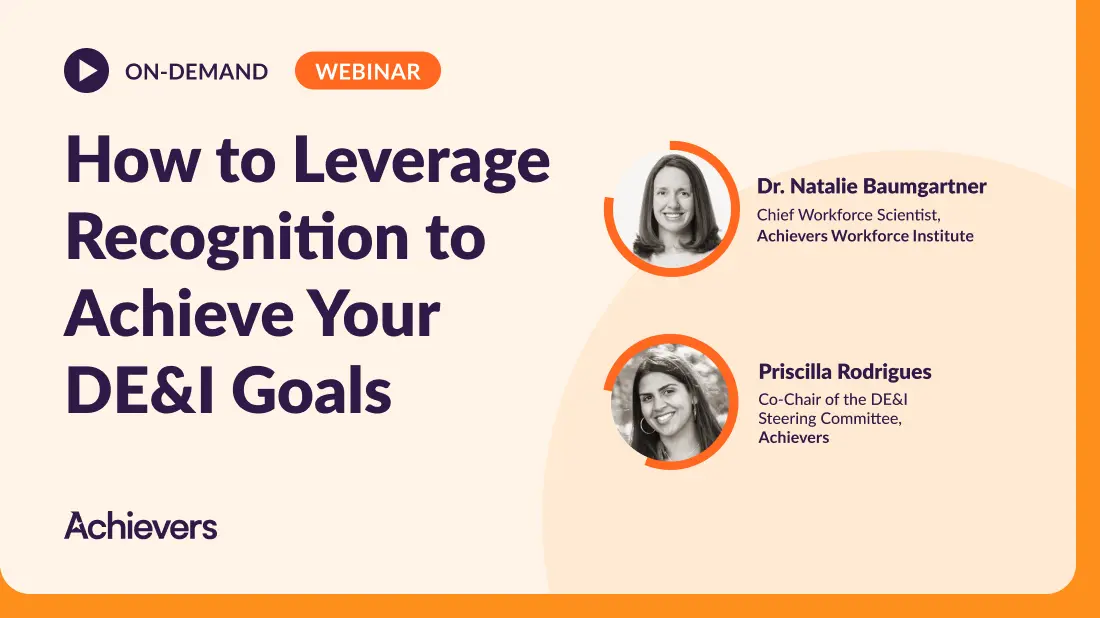Table of contents
Creating a culture of diversity and inclusion (D&I) is more important than ever. A recent Forbes survey found that 88% of employers consider D&I initiatives essential to their success, with 80% having a positive view of their impact. These efforts aren’t just nice to have — they’re essential for attracting top talent and creating a workplace where everyone feels valued.
But what are the qualities that truly define a good employee in such a workplace?
In this blog, we’ll dive into the key traits that help employees thrive. By nurturing these qualities, organizations can build stronger, more connected teams and make a lasting impact.
What is diversity and inclusion?
Diversity and inclusion is an organization’s effort, policies, and practices that ensure different groups or individuals of different backgrounds are culturally and socially accepted and integrated into the workplace. An organization that focuses on diversity and inclusion will employ a diverse team of people that reflects the society in which it operates.
- Diversity: Encompasses differences in political beliefs, race, culture, sexual orientation, religion, class, and/or gender identity. In the workplace, it means having a team with individuals who bring diverse perspectives and backgrounds.
- Inclusion: Ensures that everyone in the diverse workforce feels involved, valued, respected, treated fairly, and integrated into the company culture. It involves empowering employees and recognizing their unique talents as part of fostering an inclusive environment.
Both aspects of D&I are important 一 diversity without inclusion can result in a toxic workplace culture, and inclusion without diversity can make a company stagnant and uncreative. Companies are starting to focus more on diversity, but many disregard the inclusion piece of the puzzle. Without a concerted effort towards both inclusion and diversity, your workforce will feel out of place and unsupported.
What is DEI&B?
DEI&B stands for diversity, equity, inclusion, and belonging. In the workplace, these are organizational values demonstrated through hiring individuals of different backgrounds and perspectives and encouraging their participation and success. Diversity includes equal representation of different ethnicities, ages, and genders.
Belonging, in particular, is a term that has been at the center of workplace conversations recently. The Achievers Workforce Institute (AWI) defines belonging as an experience of connection, security, and community — it’s about feeling at home in one’s place, without reservation. A true sense of belonging at work is the deepest outcome measure of engagement.
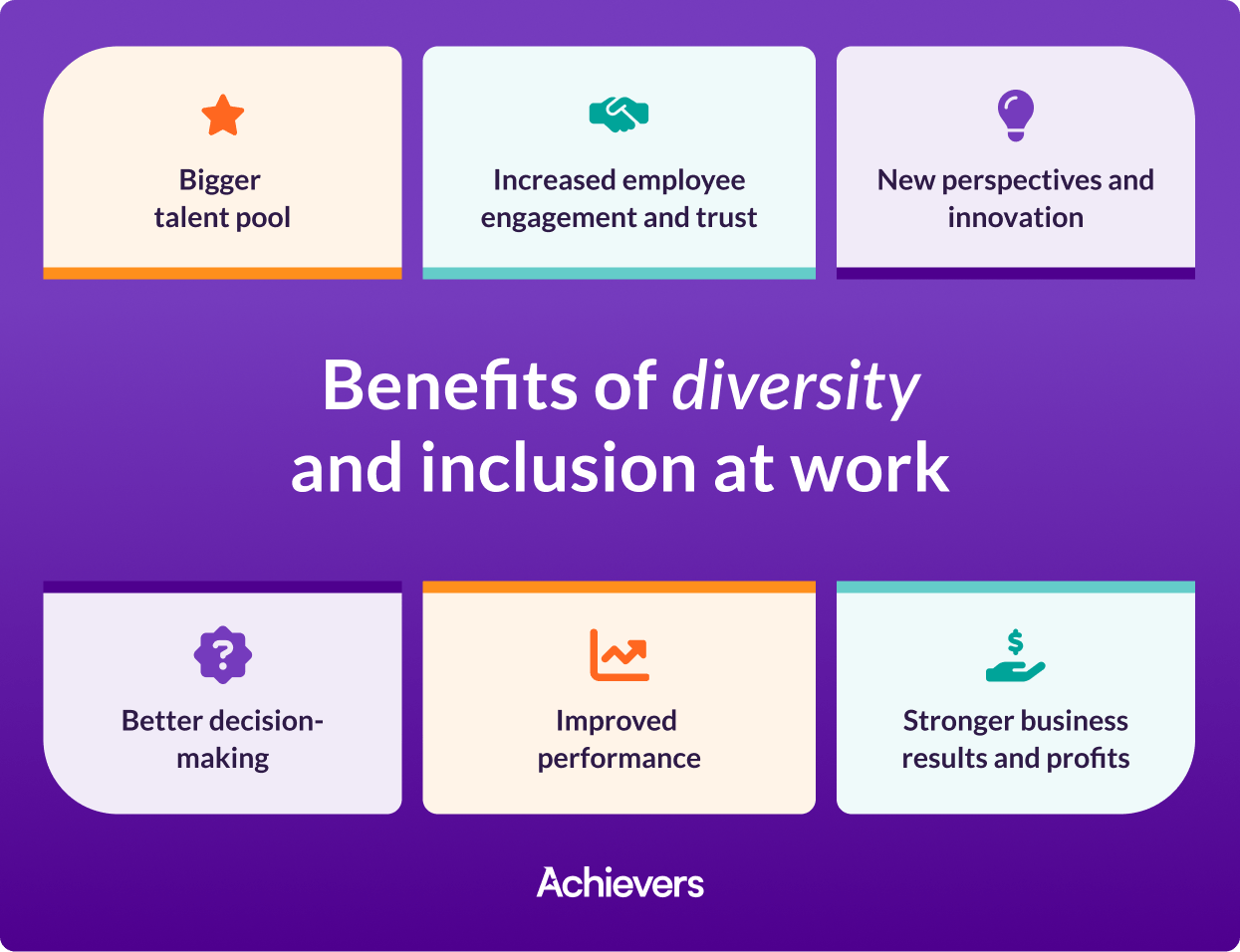
Benefits of diversity and inclusion at work
- Bigger talent pool
- Increased employee engagement and trust
- New perspectives and innovation
- Better decision-making
- Improved performance
- Stronger business results and profits
A diverse and inclusive environment establishes a sense of belonging among employees, making them feel more connected and productive. Organizations that adopt D&I practices see huge gains in the form of business results, innovation, and decision-making.
Bigger talent pool
Expanding your recruitment searches to more diverse candidates — including background, ethnicity, age, etc. — widens your talent pool and increases your chances of finding the best hire.
Diversity also plays a crucial role in driving business success. For example, Delta Airlines attributes a 10% boost in global market penetration in 2024 to its enhanced D&I initiatives. By prioritizing diversity and inclusion, companies can unlock new opportunities, foster innovation, and build stronger connections with both their workforce and customers.
Increased employee engagement and trust
When employees feel included, they’re more engaged and go the extra mile for the organization, having a ripple effect on profitability, team morale, and retention. People working in inclusive workplaces also tend to have better physical and mental health and take less leave for health issues.
New perspectives and innovation
Recent findings from Korn Ferry reveal that 80% of the world’s top companies intentionally build diverse and inclusive teams to boost performance and spark creativity. Research also shows that teams designed with diversity make better decisions 87% of the time and are 70% more likely to tap into new markets.
Improved performance
Diversity is a competitive differentiator. Companies with significantly more racial and ethnic diversity are 35% more likely to outperform competitors. This diversity leads to richer perspectives, innovative solutions, and a broader understanding of customer needs.
Stronger business results and profits
Diversity brings more than just a positive workplace culture — it directly influences a company’s bottom line. When businesses embrace diversity, they unlock the potential for greater creativity, innovation, and problem-solving, which translates into more impactful products, services, and strategies.
What are examples of DEI?
Bringing DEI to life within your organization can take on various forms. Examples include:
- Celebrating diverse holidays and important dates for different employee groups
- An address/statement to employees from the CEO/senior leadership team
- Creating mentorship programs for underrepresented groups
- Publishing content or a video on diversity in your workplace on your website or social channels
- Revising your employee value proposition to include a focus on DEI
What are 4 types of diversity in the workplace?
The four types of diversity in the workplace are:
- Internal: Situations that a person is born into
- External: Things related to a person but aren’t characteristics they were born with
- Organizational: Differences between people that are assigned to them by an organization
- Worldview: A multitude of factors (including the above) that come together to form our worldview
An organization needs to understand and address each of these areas to better address diversity in the workplace.
What are the 4 pillars of diversity and inclusion?
To nurture and drive diversity, equity, and inclusion in the workplace, it’s important to have a framework that guides an organization’s efforts. The four key pillars to include in your strategy should be:
- Community
- Growth
- Education
- Engagement
What are the core values of diversity and inclusion?
Equity and connection are values at the heart of diversity and inclusion. At its core, diversity and inclusion are intended to support different groups of individuals, such as those from different races, ethnicities, religions, abilities, and genders.
Many organizations build their diversity and inclusion values and strategies into their overarching core company values so that they are an intrinsic part of the organization’s guiding principles.
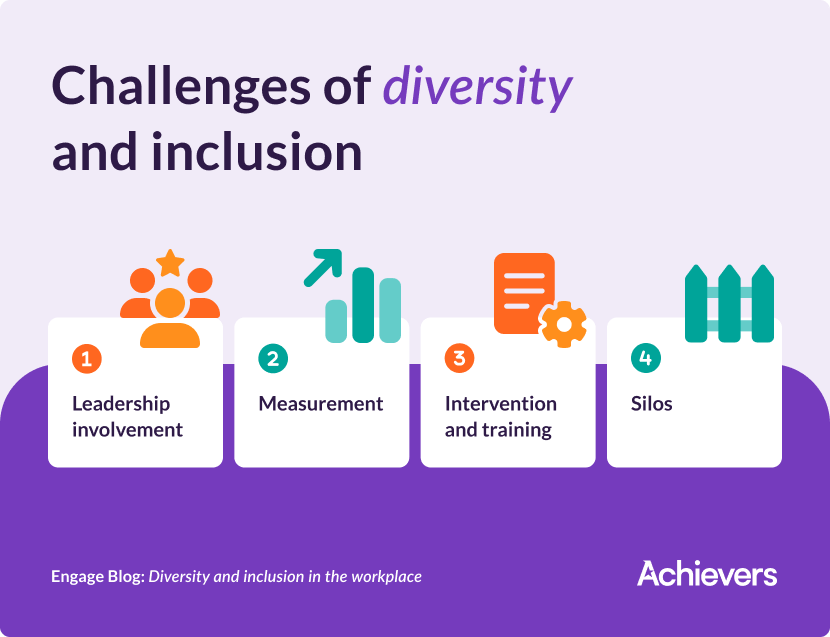
Challenges of diversity and inclusion
Creating a diverse and inclusive workplace is easier said than done. Here are some of the top challenges that organizations face when it comes to leveling up their diversity and inclusion strategies:
Leadership involvement
Organizational change begins at the top. Upper management needs to allocate resources to D&I efforts, even in the face of uncertainty.
Once you’ve garnered adequate support, ask critical questions about your company’s workforce. Oftentimes, these questions bring about tough, but necessary, conversations to drive true change.
HR department and individual managers are responsible for enacting change and sustaining a D&I-centric culture. These groups should receive training and present a unified front that upholds D&I practices while measuring the company’s progress toward D&I goals.
Measurement
The only way to know if D&I is improving in your organization is to measure and track it. An annual survey is not enough. You need to practice continuous listening and collect real-time insights into what your employees are thinking and feeling.
Continuously allow employees to voice D&I concerns, as they have an in-the-trenches view of possible conflicts that managers may not. Use this feedback to think of new ways to incorporate people-centric initiatives and build a trustful relationship with employees to foster better overall performance.
Be sure to measure diversity and inclusion-related KPIs before and after implementing each new D&I initiative. Look at the change (or lack of change) in metrics. Coming up with diversity KPIs is relatively simple if you break down your workforce by gender, race, geography, etc.
Remember, gathering data is just one piece of the puzzle. You need to follow up and take action to ensure that you’re using insights to strengthen your approach and impact.
Intervention and training
Managers require training on D&I goals, why they’re important, and what’s expected of managers. Leadership teams need to lead by example, from integrating D&I into their hiring interview process to the way they treat their fellow employees. Every manager should build an inclusive team environment by recognizing their biases, listening to their employees, and recognizing them for their everyday efforts. Employees should also receive D&I training to help avoid and overcome biases.
Training sessions need to show that companies know about current biases in the workplace and explain how your D&I program is an opportunity for all employees to acknowledge and improve.
Silos
Many organizations struggle with silos which encourage exclusivity rather than inclusivity, decrease productivity and productivity, etc. Before deploying a recognition program, Meijer, a family-owned superstore based out of the U.S. Midwest, was aware that silos could severely hinder collaboration. After implementing their recognition program, the strength of networks in each Meijer store location increased.
Breaking down silos and increasing connections across your company is instrumental in strengthening D&I throughout your organization.
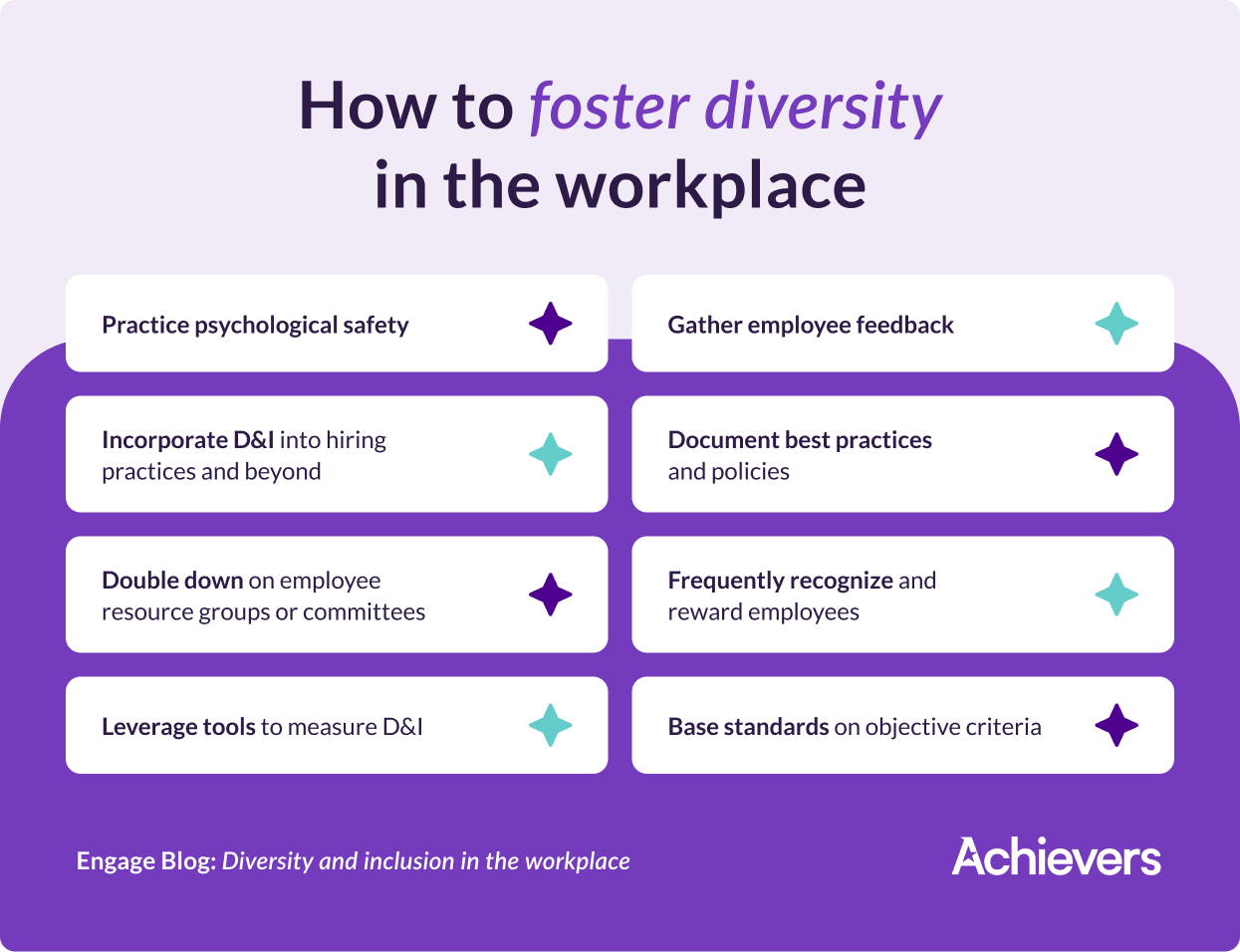
How to foster diversity and inclusion in the workplace
- Base standards on objective criteria
- Frequently recognize and reward employees
- Leverage tools to measure D&I
- Double down on employee resource groups or committees
- Practice psychological safety
- Gather employee feedback
- Incorporate D&I into hiring practices and beyond
- Document best practices and policies
There are myriad ways to start incorporating diversity into your workplace. Here are a few of the ideas to get started:
Base standards on objective criteria
Using objective criteria can help minimize bias and ensure fairness. It’s important to gather your team to openly discuss and align on these criteria, working together to build plans that address unconscious bias. To get everyone’s input and create actionable strategies, consider leveraging tools that facilitate collaboration and track progress, ensuring all perspectives are considered as you move forward with inclusive practices
Frequently recognize and reward employees
Appreciating employees for who they are shows that you care about them as a person. Take full advantage of an engaging recognition program that encourages your workforce to publicly celebrate their peers’ strengths, but also their uniqueness. Employees should be recognized by their c-suite, managers, and peers for everyday wins, both small and big.
Leverage tools to measure D&I
Use staple HR tools to monitor your progress toward becoming a more inclusive, diverse company. An employee engagement program can help you better understand your organization’s blind spots. Use your voice of the employee solution to measure how your workforce is feeling about current D&I initiatives and gather feedback on areas to improve.
Double down on employee resource groups or committees
Building employee resource groups (ERG) or networks is a fantastic way for groups of people to connect at work, especially in large organizations in which employees can feel disconnected. For example, consider starting a women’s network, LGBTQ+ network, or D&I committee.
By investing in ERGs or committees, you not only create spaces for employees to connect and feel supported but also foster a culture of belonging where diverse perspectives can thrive and contribute to the company’s success.
Practice psychological safety
A workplace must be a safe space for everyone. Establish a culture where people feel empowered to flag alarming situations, or even just uncomfortable. Workplaces that ensure psychological safety and trust help employees to speak up. When psychological safety is prioritized, employees are more likely to contribute freely, collaborate effectively, and engage with their work, leading to a healthier, more productive work environment.
Gather employee feedback
Surveys and continuous feedback platforms allow leaders to hear information directly from employees. Gathering honest feedback on a frequent, real-time basis allows you to course-correct if something is awry.
If you’re not already, try leveraging employee surveys to regularly capture your employee’s input and gather the pulse of engagement. Ask specific questions related to D&I to get employees’ thoughts on how to build a more inclusive work environment. Be ready to take action on feedback — this is critical for employees to provide feedback in the future.
Incorporate D&I into hiring practices and beyond
Diversity needs to be part of your hiring practices. Set up diverse panels of interviewers who will select candidates based on skills and experience. Train your hiring managers on unconscious bias and what can’t be asked during an interview, such as aspects of a candidate’s personal life or religion. Employees should also be open and conscious of biases they might bring into a meeting or one-on-one session with a colleague.
Document best practices and policies
A company’s policies and practices should be available to all workers at all times. The code of conduct should be updated regularly and outline the company’s approach to diversity and non-discrimination. Consider adding a non-discrimination module into your annual employee training to reinforce its importance to the company. Other policies should summarize the company’s stances on compensation and benefits, employment conditions, and termination.
Unlock the full potential of a diverse and inclusive workforce
A diverse and inclusive workforce is not just the right thing to do; it also drives growth and innovation. Achievers’ recognition platform is designed to support DE&I initiatives across multiple touchpoints. From empowering employee resource groups (ERGs) to recognizing employees working on D&I efforts, Achievers enables inclusive recognition at every level.
Our platform infuses DE&I values into your recognition programs, making sure every employee feels heard, valued, and celebrated. At Achievers, we’re passionate about creating a culture of belonging, helping organizations not just thrive, but truly excel by empowering their people.
